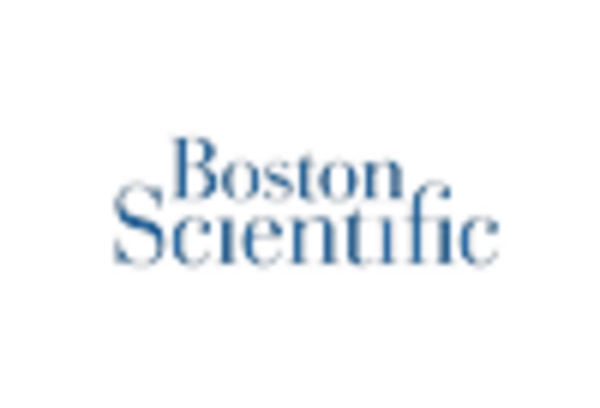Rising Healthcare Expenditure
The increase in healthcare expenditure in the United States is a significant driver for the cardiac catheterization market. With healthcare spending projected to reach $6 trillion by 2027, there is a growing investment in advanced medical technologies and procedures. This financial commitment enables healthcare facilities to acquire state-of-the-art equipment and invest in training for healthcare professionals, thereby enhancing the quality of care provided. As a result, the cardiac catheterization market is likely to benefit from this trend, as more facilities are equipped to perform these procedures. The correlation between healthcare expenditure and the growth of the cardiac catheterization market appears to be strong, suggesting a positive outlook for the industry.
Advancements in Imaging Technologies
Innovations in imaging technologies are significantly impacting the cardiac catheterization market. Enhanced imaging modalities, such as 3D imaging and advanced fluoroscopy, are improving the precision and outcomes of catheterization procedures. These advancements not only facilitate better visualization of cardiac structures but also reduce radiation exposure for both patients and healthcare providers. As a result, the adoption of these technologies is likely to increase, contributing to the overall growth of the cardiac catheterization market. Recent reports suggest that the integration of advanced imaging techniques could lead to a 25% improvement in procedural success rates, further solidifying their importance in the market.
Increased Focus on Preventive Healthcare
The growing emphasis on preventive healthcare is influencing the cardiac catheterization market. As healthcare providers and patients alike recognize the importance of early detection and intervention in cardiovascular diseases, there is a shift towards proactive measures. This trend is reflected in the increasing number of screening programs and awareness campaigns aimed at identifying risk factors associated with heart diseases. Consequently, the demand for cardiac catheterization procedures is expected to rise as more individuals seek timely interventions. The proactive approach to healthcare may lead to a 15% increase in the number of catheterization procedures performed annually, thereby positively impacting the cardiac catheterization market.
Aging Population and Associated Health Risks
The aging population in the United States is a critical driver for the cardiac catheterization market. As individuals age, the prevalence of cardiovascular diseases tends to increase, necessitating more frequent interventions. Current statistics indicate that approximately 80% of individuals aged 65 and older have at least one chronic health condition, with cardiovascular diseases being predominant. This demographic shift is likely to result in a higher demand for cardiac catheterization procedures, as healthcare systems adapt to the needs of an older population. Consequently, the cardiac catheterization market is poised for growth as it addresses the rising health challenges associated with aging.
Increasing Demand for Minimally Invasive Procedures
The cardiac catheterization market is experiencing a notable shift towards minimally invasive procedures, driven by patient preference for reduced recovery times and lower complication rates. As healthcare providers increasingly adopt these techniques, the market is projected to grow significantly. According to recent data, minimally invasive cardiac catheterization procedures have shown a 30% increase in utilization over the past few years. This trend is likely to continue as advancements in technology enhance the safety and efficacy of these procedures. Furthermore, the growing awareness among patients regarding the benefits of minimally invasive options is expected to further propel the demand within the cardiac catheterization market.

















Leave a Comment